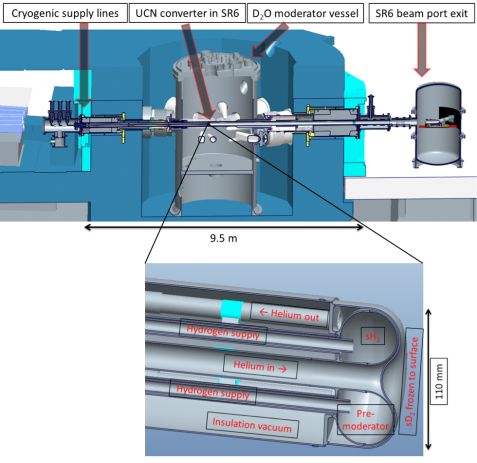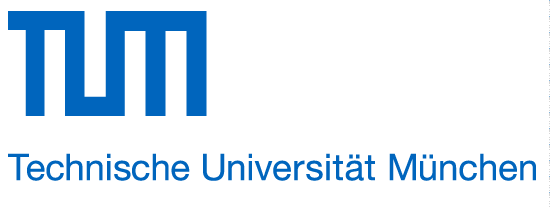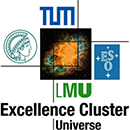MLZ is a cooperation between:
 > Technische Universität München
> Technische Universität München > Helmholtz-Zentrum Hereon
> Helmholtz-Zentrum Hereon
 > Forschungszentrum Jülich
> Forschungszentrum Jülich
MLZ is a member of:
 > LENS
> LENS > ERF-AISBL
> ERF-AISBL
MLZ on social media:

MLZ (eng)
Lichtenbergstr.1
85748 Garching
UCN source (under construction)

Top part: Cut-view (schematic) through the FRM II moderator vessel and the tangential end-to-end beam tube SR6. The cryogenic supply lines to the UCN converter are inserted from the left hand side. The converter vessel is positioned at a distance of 60 cm from the central fuel element (not shown), and at a distance of 25 cm from the middle of the SR6 beam tube. The produced UCN are extracted to the right (SR6 beam port exit) and feed into connected experiments.
Bottom part: Cut-view of the UCN converter vessel (zoomed out, schematic). Supercritical helium at 5K flows between the two walls of an aluminium converter cap, cooling the hydrogen moderator inside the vessel, and the deuterium converter frozen to the outer wall of the cap. The converter is positioned inside the horizontal through going beam tube SR6 at a distance of 60cm from the central fuel element of the FRM II. The converter head is connected to cryogenic supply lines coming from the left hand side.
The ultra-cold neutron (UCN) source is installed in the tangential end-to-end beam tube SR6. From one side (SR6b) the necessary cryogenic lines are inserted, and to the other side (SR6a beam port exit) the UCN are extracted into the connected experiments (see FIG. 1). The central part of the UCN source is the converter vessel, a double walled toroidal shaped aluminium container. It contains
UCN can easily be stored for long time periods (several tens of minutes) in bottles made of suitable materials or magnetic fields. The storage and observation time is in principle only limited by the lifetime of the free neutron. These long observation times offer the possibility to investigate the fundamental properties of the neutron with highest precision. Such experiments try e.g. to determine a possible electric dipole moment (EDM) of the neutron, a value that would help to explain the disequilibrium of matter to antimatter in the universe. Also the lifetime of the free neutron, an important parameter in the standard model of physics, can be measured with highest precision. UCN are used as well to observe quantum states of neutrons in the earth’s gravitational field, which is a test of Newton’s law in the µm-scale.
Converter temperature min
5 K
Pre-moderator volume (sH2) max.
250 cm3
Converter volume (sD2) max
250 cm3
Cooling power @ 5K max.
1 kW
UCN flux density @ SR6a exit (100 neV – 230 neV)
6·105 s-1cm-2
UCN beam aperture (circular guide)
100 cm2
UCN flux @ SR6a exit (100 neV – 230 neV)
6·107 s-1
Instrument Scientist
Dr. Andreas Frei
Phone: +49 (0)89 289-14260
E-Mail: andreas.frei@tum.de
Operated by




Publications
Find the latest publications regarding UCN in our publication database iMPULSE:
MLZ is a cooperation between:
 > Technische Universität München
> Technische Universität München > Helmholtz-Zentrum Hereon
> Helmholtz-Zentrum Hereon
 > Forschungszentrum Jülich
> Forschungszentrum Jülich
MLZ is a member of:
 > LENS
> LENS > ERF-AISBL
> ERF-AISBL
MLZ on social media:



